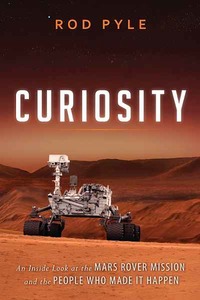Review: Curiosityby Jeff Foust
|
| While Pyle’s writing style can be chatty and a bit irreverent at times, he treats the Curiosity team with reverence, and even a bit of awe at what they’ve accomplished. |
In his book Curiosity, Rod Pyle tries to set his book apart by offering readers a glimpse inside the workings of the Curiosity mission. He visits with scientists and engineers working out in the desert prior to the mission’s landing, learning about the science they hope to perform with Curiosity and putting a engineering testbed version of the rover through its paces. After Curiosity’s landing, he sits in on the team as the meet to plan out the rover’s activities for a day. And, he interviews a number of the key people on the project, including project scientist John Grotzinger and chief engineer Rob Manning.
What comes out of this inside access is not necessarily any great revelations about the mission—no great new insights about the engineering or science of the mission, nor any salacious tidbits—but instead a fuller, more nuanced picture of Curiosity the rover, and Curiosity the mission, than one relying solely on media reports. An example is a chapter he devotes to the kerfuffle that erupted when Grotzinger offhandedly said to a visiting journalist, a few months after landing, that Curiosity was returning data that “is going to be one for the history books.” The media ran with that for a time, concluding that his comments meant that Curiosity had found organic materials—or something more profound—that kicked off a frenzy. It hadn’t, of course; Grotzinger was referring to the data from the mission in general. Pyle helps explain that incident and provide some useful context.
Pyle is, in many respects, also a character in this book, for better or worse. In the book’s first chapter, for example, he recounts his participation in a geology field trip in Death Valley with Grotzinger and other journalists to get a hands-on feel for the geology Curiosity would encounter, struggling to lug heavy camera gear in the heat; at times, you wonder what, if anything, this has to do with a Mars rover. Elsewhere in the book he interjects his thoughts or asides, or other personal recollections, such as recalling his distaste for meetings he developed in academia while preparing to sit in on a Mars rover planning meeting. (Fortunately, the rover meeting turned to be far more pleasant and collegial for him than he expected.)
While Pyle’s writing style can be chatty and a bit irreverent at times, he treats the Curiosity team with reverence, and even a bit of awe at what they’ve accomplished. He profiles not just major team members like Grotzinger and Manning, but also a number of the lesser-known engineers and scientists who made the rover and use it to help unlock the secrets of the Red Planet. He writes how one team member, besides working on the mission, “performs all sorts of community good deeds,” including coaching a local sports team. “I rarely found time to even attend my kid’s soccer games, much less coach them,” Pyle writes. “Sheesh.”
With more books on the way, Pyle will hardly get the last word on Curiosity (he will be out-insidered by Manning himself, who is the co-author of a book about the mission due out in October.) However, he does provide some enlightening and even entertaining words about the mission in Curiosity.
